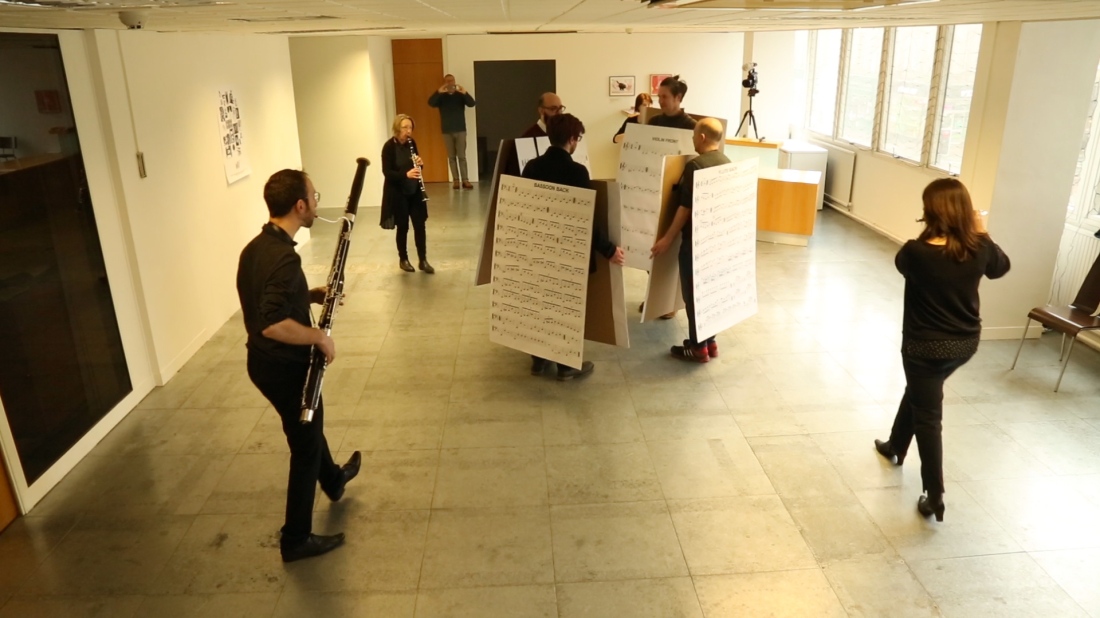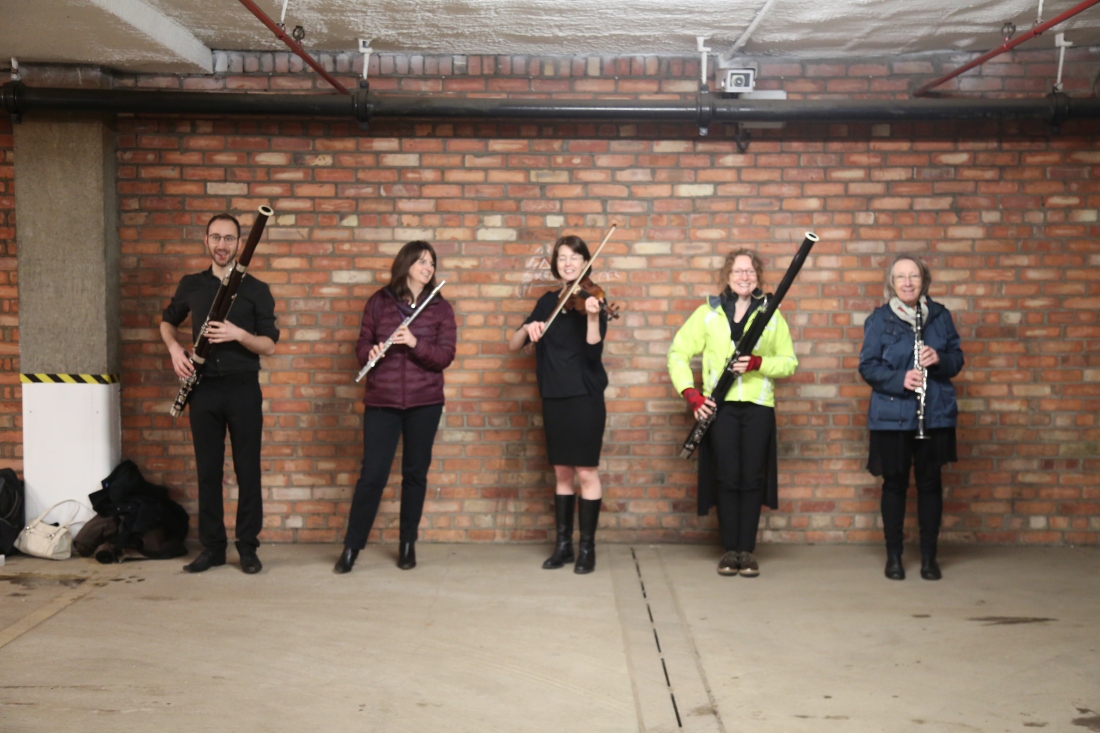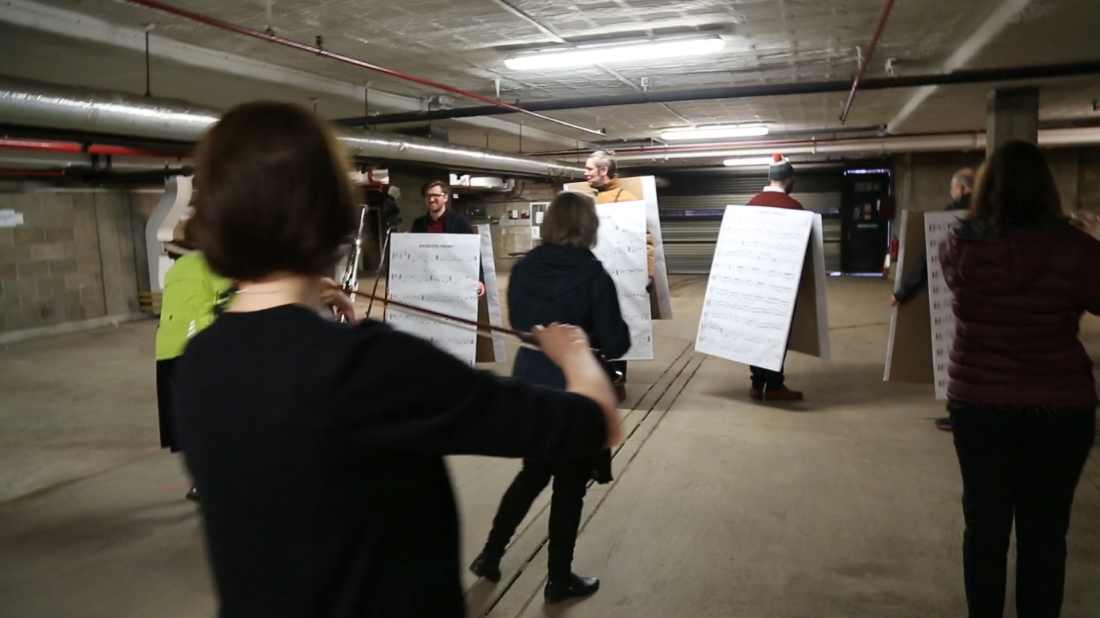

Undertook this session in the Vane gallery space so a new space. It was insightful experience and changed the structure through a number of test runs with different parameters, with myself in and out of the experience . I thought to begin the space would be restrictive. But In some way it is as far back as the players can go can go, and still read the music. So it has a natural limit to the area in which it can occur. Also the amount of music I had was actually more than they ever managed to complete. Interestingly, when we did go to a larger public space I found the big garage space in some way diminished the feeling of connection between the person with the music and the player.
Afterwards Chris who works at Vane, said it was kind of disconcerting to have classical players so close, with their instruments, it was otherworldly. Does the art game structure break down that fourth wall, compress the distance between players and audience not only geographically but also psychologically. Is this somehow reinforced by turning away from the players but having the advance on you, then turning back and finding them close. I myself did find this startling at times. I consider this in relation to mastery and empowerment that games give players, and is part of their ability to maintain attention through the play experience. Thinking on my other work, with players and orchestras and classical music, I was interested in notes, and in players live, moving. Getting players to move and play is hard, but this game structure embeds into in the mechanics. I find where as before in earlier works players had grumbled, here they seemed to really enjoy the challenge of moving. Perhaps it is the input of a Lusory goal?
Rules: So that one side, the back, has the music they play and move too, then the other has the music they play when still. There are four of us, each with different parts on, and the four instruments that relate to those parts. So eight in total. This seems to works well, and progressed the idea from my original notion of people turning and stopping the playing, with there being no notes though. It started to make sense having the two tunes, rather than silence and standing and then moving and playing. Is there some power dynamic where even though the participants with the music can’t play they control the players, who have all the skills. There is though no learning curve for the participants, they don’t get better at the task, or really learn anything from undertaking it.
ROUND 1: In the first try we decided as a group to do it together, in unison. We played this and it was exciting I thought. Andy explains to the players to keep a beat, so that when we turn, even though they are still, they still keep to the same beat! Amongst themselves the players have agreed to always whichever side to go back to the beginning of the four bar phrase. Andy is helping in the gap in the game, by clicking out the rhythm
After this round I added the game mechanic that the players are sent to the back, if they are seen to move. So this intrudes more jeopardy for them, and more mastery for the participant wearing the music. This also increased the negotiability in the game between players and participants as to their move being seen.
ROUND 2: So it changed the dynamics of the sound. As some got more to the fore, and it also seemed to make the players more competitive, with each other, and with us. We still worked together as group though. As expected it also made the game-play time longer. Andy raises the problem that if we are doing it together and one of us is saying when to turn, we need to find a way to do this silently, so as not too alert the players. Watching footage, when a shot holds on the faces of participants wearing music, and you hear the soundtrack of the players in distance, as a watcher you wonder what they are thinking. I notice Mick has his eyes closed and seems contemplative. Watching back and thinking about the aesthetics, it is more effective choreographically and fits with the music more in a way visually when we are all turning and stopping simultaneously. Mick seems to have taken control of telling us when to turn. I note that we all have an awareness of each other and that any can actually lead.

ROUND 3 and 3(a) same configuration: This round decided we should do it separately, so each of us decided when to turn. This added a stronger sense of connection I found between myself and the player, as now I focused more on my individual player. Also it made it easier to send players to the back, as was concentrating on mine rather than them all. I also found for myself it was visually more appealing as a player, as I could see the other players moving, that aren’t controlled by me. Also this revealed different strategies between us with the music and how we affect our player. The music Andy thought, and myself became more interesting once we split up the players. I did less turns I noticed that the others who I watched.
This once more bought up the difference between gamefulness, the most gameful, and the artfulness, the most artfully pleasing! Maybe if there is a slider with each at one end, then this aspect maybe made it more gameful but less aesthetic. But the more I heard it ,the more interesting the music became. It created the chance element in the score with it different each time, with the turning creating more dissonance. It also seemed to make the players more competitive as well against each other than before when they were a team. In the earlier rounds they seemed one the players, where as now they were competitive against each other. The players got into the idea of tapping the person with their instrument so signal game end. I had imagined a line to cross, but this I felt was more interesting and made the participant who was turned away jump a bit. At one point Mick turned and the player touched at same time and there was disagreament about if that was a win situationfor the player. Andy though some kind of referee would be good but I think that a negotiation between us is enough. Then for the next Round. It was suggested that we, the participants with the notes on, move along the horizontal as well. Now I see it, is the turning and sending the players back kind of defensive, while approaching is kind of attacking. Are they playing separate strategies, but without cross over. I also stated, that even if the players now knew the music they had to follow it still, read it. So an arbitrary rule, as in Suits lusory contract. It was a bit solemn the first turn, now with sending people back it seems more jovial. Humour is starting to come though. We seem to be getting dramatic in the way we turn. There is a walk of shame aspect when the player is almost there and then has to walk the whole way back. It has more impact when they are a team, as the rest halt and the person walks all the way down the room with us all watching. They seem almost chastised. Also Andy asked is it just the one person touching that wins. It was the Bassoon. So up till now perhaps even though one person touched to win, they represented the whole but now with us as having greater separateness, are the players more separate, and are they now playing against each other rather than before where it was us and them. So is it, each player against each turner, but also each player against each other. So the end touch is a win only for that player. Where as I don’t feel any greater competitiveness against my other turners
ROUND 4: So here, we the participants with the music could move across the space. Mick says shuffle, I think he means shuffle down, I start saying lets shuffle down, but then he explains the shuffle concept. Interesting at last to see how that effects the path of the players. Is this the idea that the players in some way have paths? We stagger each other so we don’t knock into each other, and I tell the players ‘TO BE CAREFUL’. They though also stagger themselves, so the distance is equal for all. This seemed to add an extra mechanic, and a further strategy to our relationship with the players. It made it more difficult for them, and seemed to add length to the play experience. It also bought us back working together as more of a team. So we individually controlled our player but worked more as a team when shifting around. So this seems a strong addition, and allowed the best of all experiences. A bit chaotic, but more fun and challenging and made for more camaraderie between us the participants. Andy and players say they like doing this, that it is genuinely playful. This makes me think about the difference between play and games. Is it gameful. It has rules and feel it has a strict game mechanic, will little space for free play, so it is interesting that it seems kind of playful and chaotic, but has deep game rules embedded into it. Andy is directing them to count bars which will help them when stopping and starting. Mick points out his strategy is that he is trying to get people mid step. Can the participants with their back turned do this, could you tell listening to the music as a cue when the players are most vulnerable to being sent back.
ROUND 5: I then decided to try an individual participant with one instrumentalist. Though we had an extra bassoon player come in, and so then decided to have one player against the two instruments. This though reminded me of the original idea, of a whole orchestra and just one player controlling them. So Asymmetry in the structure. I also as there were only two sent them into the little room at the end of our space so it elongated the play space somewhat and they kind of emerge into the play space from the alcove. So now I could watch the activity. It was nice hearing the sound before you see them play. As the two bassoons played, they seemed more competitive with each other than they had when all were playing.
Round 5a – Same configuration.
Am calling this A as the tule set stays the same. Though noticed this was the longest game. Almost 3 mins. Thom seemed much more severe in the way he sent people back. He applied the mechanics against the players more strictly which lead to the prolonged gameplay. Am unsure if you did send the players all the way back when they are really near, that they would find having to do it all again that pleasurable.
ROUND 6: Then tried it with two participants wearing music and three instruments. The clarinet and the two bassoons, so three against two. An asymmetrical play experience. I put the clarinet in the middle, and still had them emerge from the room. Thinking back to the idea of many players and a single participant, this is a way to do that. As the orchestra is divided up into sections, with many players playing on the same instrument the same part,it could be exciting I guess, or exploratory to see what happens if you did get a whole orchestral section of say ten violins to play the game on the one person. I thought that when I had moved to the notes, that original idea dissipated, but now I see it could work. With the various orchestral sections. They are more sneaking, but the game doesn’t really call for that. Now watching it, is there a way to bring sneakiness into it. I was into at one point the idea of playing the music softly, but Andy wasn’t in to this. Is there a way to add a sneaky game mechanic into the art game. Like the duck and cover in certain video games mechanic. The bassoon player is blocking the other player in order to let the other bassoon go forwards. Blocking as a mechanic, which arises when there is a team of the same instrument. So they are playing against the solo player, while also all are playing against the people with the boards. These new mechanics change the game dynamic. If there are more than one player, then if one sent back, the other is still out in the field or play. Asymmetry against the single player. The Bassoon won

ROUND 7/7a: Then decided to try the huddle which was one of my first notions for the set up rather than the line. First go was back to us in unison, then us separate. So we all with the music form a circle, and the players approach from different corners. This completely changes the game dynamics. I could now see the other people with music, and one approaching player over the shoulder of that person, so could signal in some way. It seemed though to lessen the experience, to make it less gameful, and we all felt that structure wasn’t very successful as it broke the experience up visual too much by separating everyone, and the lines for the viewers around. But in the footage I feel now this is the most visual. I felt more isolated in this configuration. Camerman Pomenad does say about us all looking scared a bit. Watching the footage the players seem more powerful. It does seem a bit like they are hunting us down. Now wish I had done it in garage space like that.
The asymmetry of this is starting to come more to the fore, the players have lots of complex things to do and keep in mind, moving, and playing and keeping time. Where as the participant role is fairly simple. Perhaps the player are in a gameful state, high and the participants are in a more playful state. Can you have two status states, playful and gameful, but divided in a single structure. Is this somehow how the non professional can segue in alongside the professional
GARAGE SPACE


ROUND 8 : So wanted to try this out in garage, get some greater distance on it. See how it works in an urban space, the acoustic etc. Returned to the original structure of all the players moving together and us with the music turning as a team. I now found this a bit flat, maybe because it breaks the connection to a single player. Also the larger space seemed to dissipate the activity for me, I didn’t feel as connected to a player. Also the sound wasn’t as strong. Though they looked good against the brick of the back wall. There were pillars as well, and I started to think about them hiding behind pillars or something, or us moving and them chasing us, more of a tag structure. Though I didn’t act on these thoughts.
ROUND 9: So to end went back to the shuffling and individuals. Though maybe this time it all got very chaotic at the end, perhaps we were all tired, but the whole thing had a great energy.

GENERAL THOUGHTS:
Doing it in the garage made me wonder if it did have the visual impact I was after. Andy started to think that if we did it in public maybe we should demarcate the space. This returned me to the circle, and for the research could look at how steadily increasing the boundary, from chalk, to tape etc, to maybe some cones etc might affect the circle experience and aesthetic. Does the basoon have an advantage due to its length in the touching in the end. When watching footage It is interesting to see what was happening while back turned, as I was in it facing away it seems like spying now to see what was happening. I may call it WHILE YOUR BACK IS TURNED. This I suppose fits in with what is our relation to music. The idea of the eye contact of the players. When they play together.The different instruments react differently, and some instrument are easier to walk and play than others, this could be a feature. So the game is asymmetrical again from the players side. Though wonder if the playing skill of the player is actually part of it as well. I am also wondering about the role of the conductor or the soloist in relation to this game artwork. With multiple of players, against individuals, it is a good chance to test out the idea of asymmetry in game-play to create an aesthetic. In addition the more players there are is their a rise in the mastery the participant feels as they control them. Wish I could try this. When we moved to the idea that the participants could move across the horizontal, we then started to think about having maybe sections etc, like gates that the players had to pass though, or sections on the floor. But I don’t really like that. There is a progression through the day. Too begin it was a bit low the energy levels, but gets exuberant and raucous, with players moving very quickly by end. The first game is over two minutes, with the simple mechanics, last game, more complex, across a longer space, is 45 seconds.